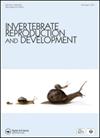巴西东南海岸蜘蛛蟹Libinia spinosa gu, 1832的相对生长和性成熟(短肢纲:大总科:蜘蛛蟹科)
IF 0.8
4区 生物学
Q4 REPRODUCTIVE BIOLOGY
引用次数: 0
摘要
摘要:本文研究了棘叶线虫(Libinia spinosa)的相对生长和性成熟(性腺和形态)。2000年1月至12月,在Ubatuba使用拖网对螃蟹进行取样。在异速生长的基础上,根据CPL(主趾前肢长度)与CW(头胸宽度)的关系将雄鱼分为幼年(MJ)、少年(MAd)和成年(MA),均为正异速生长。对于雌性,AW(腹宽)与CW的关系允许幼鱼(FJ)与成鱼(FA)分离,FJ呈正异速生长,FA呈等长生长。MAd、MA和FA的形态成熟度从33.7 mm到34.5 mm不等。50%的个体达到形态性成熟时,雄性L50 = 50.1 mm,雌性L50 = 37.3 mm。雄性性腺成熟度L50 = 33.7 mm,雌性性腺成熟度L50 = 36.9 mm。通过相对生长分析,我们确定了一个青春期男性组(青春期前)。这些个体呈现出成熟的性腺,使它们能够与雌性交配。这些青春期雄性可以在避免与成年雄性竞争的情况下繁殖,就像在种群中存在两种以上形态的其他大idea物种一样。本文章由计算机程序翻译,如有差异,请以英文原文为准。
Relative growth and sexual maturity of the spider crab Libinia spinosa Guérin, 1832 (Brachyura: Majoidea: Epialtidae), from the Southeast Brazilian coast
ABSTRACT We investigated the relative growth and sexual maturity (gonadal and morphometric) of Libinia spinosa. Crabs were sampled at Ubatuba from January to December 2000, using trawls. Based on allometric growth, males were grouped into juveniles (MJ), adolescents (MAd) and adults (MA) based on the relationship CPL (major cheliped propod length) vs. CW (cephalothorax width), all with positive allometric growth. For females, the relationship AW (abdomen width) vs. CW allowed segregating juveniles (FJ) from adults (FA), with positive allometric growth for FJ but isometric growth for FA. The morphometric maturity evidenced for MAd varied from 33.7 mm to 34.5 mm and for MA and FA. The size at which 50% of individuals reach the morphometric sexual maturity was L50 = 50.1 mm for males and L50 = 37.3 mm for females. Gonad maturity was L50 = 33.7 mm for males and L50 = 36.9 mm for females. Through relative growth analyses, we identified an adolescent male group (prepuberal phase). These individuals presented mature gonads, enabling them to copulate with females. These adolescent males may reproduce while avoiding competition with adult males, as it happens in other species of Majoidea that present more than two morphotypes in the population.
求助全文
通过发布文献求助,成功后即可免费获取论文全文。
去求助
来源期刊
CiteScore
1.90
自引率
0.00%
发文量
21
审稿时长
>12 weeks
期刊介绍:
Invertebrate Reproduction & Development ( IRD) presents original research on the reproductive and developmental biology of the Invertebrata, both embryonic and postembryonic. IRD welcomes papers reporting significant results obtained using new techniques. Encouraged topic areas include: aquaculture, physiology, biochemistry, functional morphology, phylogeny, behavioural and regulatory mechanisms, including genetic, endocrine and molecular studies. Papers containing qualitative descriptions of reproductive cycles and gametogenesis will not be considered. IRD is published in association with the International Society of Invertebrate Reproduction and Development.

 求助内容:
求助内容: 应助结果提醒方式:
应助结果提醒方式:


